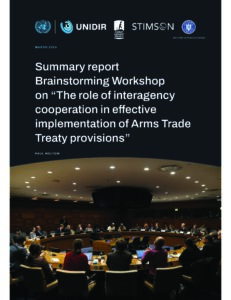Introduction
The Arms Trade Treaty (ATT) is the world’s first global, legally binding instrument to regulate the conventional arms trade. The treaty, which entered into force in 2014, aims to mitigate the harm caused by irresponsible and illegal arms transfers by establishing common standards for international transfers of conventional weapons. The treaty also aims to improve transparency and build confidence between States engaging in international arms transfers and establishes mandatory reporting mechanisms.
The ATT requires States Parties to submit two reports to the treaty Secretariat in order to increase responsibility, accountability, and transparency in the arms trade.
- First, States Parties are required to submit an initial report on treaty implementation that provides details on national laws and measures regulating arms transfers. States Parties are required to update this report should they make changes to their national arms transfer control systems.
- Second, States Parties are obliged to submit annual reports on authorized or actual arms exports and imports that occurred during the previous calendar year. These reports are due by 31 May each year. In practice, however, the ATT Secretariat extends a seven-day grace period for the submission of annual reports, creating a de facto annual reporting deadline of 7 June each year.
Comprehensive and consistent annual reporting on arms transfers under the ATT has several benefits:
- Enhancing awareness of regional and global arms flows;
- Supporting efforts to monitor whether weapons use complies with international human rights and humanitarian law;
- Providing a baseline of legally transferred arms that can be used to identify illicit arms and their potential sources;
- Contributing towards the detection of early warning signs of potential conflict, such as potentially destabilizing weapons accumulations;
- Facilitating assessments of treaty compliance, particularly related to export and import decisions;
- Providing a basis for bilateral or multilateral consultations on transfers that may not align with ATT obligations; and
- Promoting transparency and building confidence among States involved in the global arms trade.
Unfortunately, annual reporting under the ATT is not meeting its potential. Over the past six years, the rate of compliance with the treaty’s annual reporting requirement has steadily declined. Meanwhile, reporting trends that hinder transparency and limit analyses of global weapons flows – including “private reporting” and the withholding and aggregating of key information – have continued.
This report examines whether ATT annual reports contribute to a comprehensive understanding of States Parties’ arms exports and imports and assess the extent to which they provide greater insight into global arms trade dynamics than would otherwise exist. In doing so, this report takes stock of the reporting trends and challenges that have emerged over the first six years of ATT annual reporting. The report is composed of five sections. Section one provides an overview of the status of ATT annual reporting as of 31 December 2021. Section two examines trends in reporting compliance and transparency over the first six years of ATT annual reporting, and section three compares reporting under the ATT to reporting under the UN Register of Conventional Arms (UNROCA). Section four discusses reporting challenges States Parties have identified that undermine consistent and comprehensive reporting. Finally, section five provides an overall assessment of ATT annual reporting and identifies opportunities and resources that exist to assist States Parties in fulfilling their ATT annual reporting requirement.
For detailed insights on ATT initial reporting over the last six years, see Taking Stock of ATT Initial Reports.




